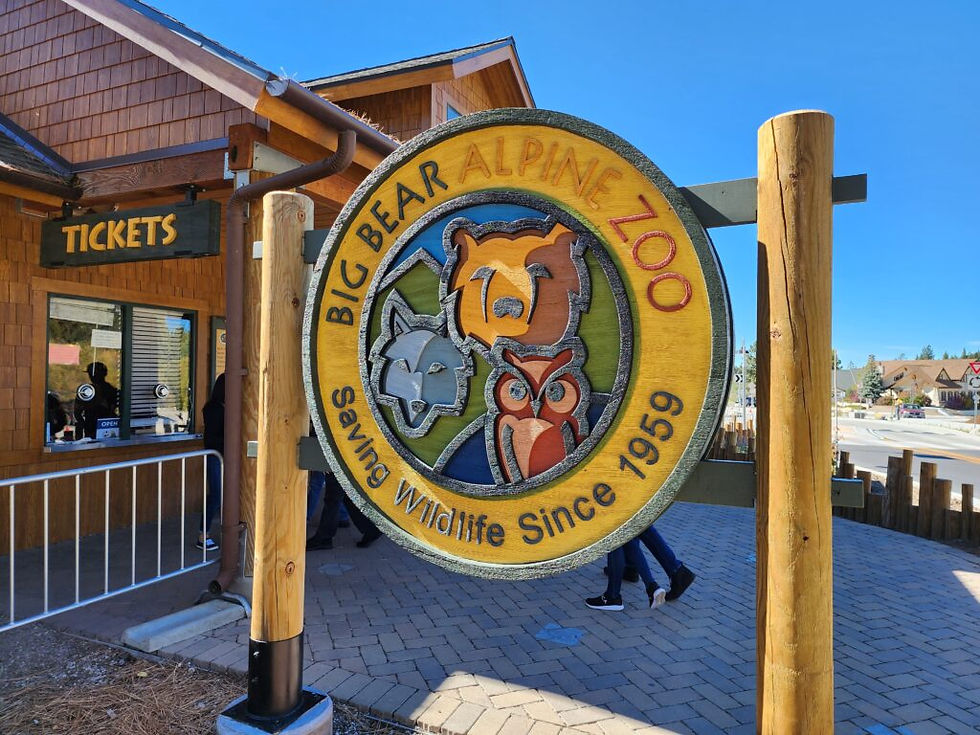Nestled in the heart of the San Bernardino Mountains, the Big Bear Alpine Zoo offers a unique and thrilling wildlife experience. This hidden gem in Big Bear provides visitors with an up-close look at native alpine animals, making it a must-visit destination for nature enthusiasts and families alike. With its stunning mountain backdrop and commitment to animal welfare, the zoo has become a beloved attraction in the region.
As visitors explore the Big Bear Alpine Zoo, they'll encounter a diverse array of wildlife, from majestic bears and wolves to playful foxes and birds of prey. The zoo's dedication to conservation and rehabilitation programs sets it apart, giving guests a chance to learn about local ecosystems and wildlife protection efforts. Whether planning a day trip or incorporating it into a larger Big Bear adventure, the zoo promises an educational and inspiring experience that will leave lasting memories for all who visit.

Planning Your Visit
Location and hours of operation
The Big Bear Alpine Zoo is open daily from 10:00 AM to 4:00 PM, with the last entry at 3:30 PM. Visitors should note that on snowy days, the zoo may open later or not at all for snow removal. It's advisable to call ahead at 909-584-1299 to confirm operating hours during inclement weather.
Admission fees and membership options
General admission prices are as follows:
Adults (Ages 13-59): $16.00
Seniors (Ages 60+): $11.00
Youth (Ages 3-12): $11.00
Children 2 and Under: Free
The zoo offers a military discount of $11.00 for serving or retired military personnel with ID. Group discounts are available for parties of 10 or more, with $1.00 off per person when visiting together.
For those planning frequent visits, the Friends of the Big Bear Alpine Zoo offers various membership options, ranging from basic to premium levels. These memberships provide benefits such as free zoo admission for a year, discounts at the gift shop, and reciprocity to participating zoos and animal parks.
Best times to visit and seasonal considerations
The off-season, which falls in spring (April to June) and fall (September and October), is an ideal time to visit Big Bear Alpine Zoo. During these months, visitors can enjoy pleasant weather with temperatures around 70 degrees Fahrenheit, perfect for outdoor activities and exploring the zoo. The off-season also offers the advantage of fewer crowds and potentially lower rates for accommodations.
Zoo Highlights and Must-See Attractions
Popular animal exhibits
The Big Bear Alpine Zoo boasts an impressive array of native wildlife. Visitors can marvel at majestic creatures such as black bears, grizzly bears, and mountain lions. The zoo's snow leopard exhibit is a standout attraction, offering an up-close encounter with these magnificent cats. Other popular exhibits include the gray wolf, bobcat, and bald eagle displays. For those interested in smaller creatures, the zoo houses fascinating animals like the African pygmy hedgehog, striped skunks, and various snake species.
Special events and programs
The zoo offers exciting daily programs to enhance the visitor experience. Every day at noon, guests have the opportunity to get up close and personal with one of the animals in the zoo's care. Keepers bring out different animals, providing an intimate and educational encounter. The zoo also hosts seasonal events, including a Fall Festival and Winter Wonderland celebration, which help raise funds for the facility's conservation efforts.
Photo opportunities and viewing areas
With its stunning mountain backdrop, the Big Bear Alpine Zoo provides numerous photo opportunities. Visitors are encouraged to bring cameras to capture memorable moments with the diverse wildlife. The zoo's layout offers various viewing areas, allowing guests to observe animals in naturalistic habitats. The Wildlife Theater is another highlight, featuring educational shows about the zoo's residents and conservation efforts.
Conservation Efforts and Rehabilitation Programs
The Big Bear Alpine Zoo stands as a beacon of hope for injured, orphaned, and imprinted wild animals. This facility offers a safe haven for animals in need, providing temporary care while they heal or permanent residence for those unable to survive independently in the wild. The zoo's commitment to wildlife rehabilitation has made it the go-to facility for local, county, state, and federal entities, as well as other non-profit organizations and the public.
Success stories of rehabilitated animals
The zoo's rehabilitation efforts have yielded impressive results. In a heartwarming example, seven baby skunks were brought to the zoo after their mother was hit by a car. Through dedicated care, all seven were successfully released together in Riverside. Another touching story involves Asha and Shanti, two animals who found a home at the zoo where they continue to receive specialized medical care while inspiring visitors with their zest for life.
Current conservation projects
The Big Bear Alpine Zoo is actively involved in several conservation projects. These include the reintroduction of the California condor and efforts to protect the Sumatran tiger. The zoo's conservation team has also been working to safeguard the habitat of the endangered mountain gorilla and combat poaching and illegal wildlife trafficking.
Conclusion
The Big Bear Alpine Zoo offers a unique and enriching experience for visitors of all ages. Its commitment to wildlife rehabilitation and conservation has a profound impact on local ecosystems and endangered species. The zoo's diverse array of native alpine animals, coupled with its educational programs and special events, provides guests with an opportunity to connect with nature and gain a deeper understanding of wildlife preservation.
For those planning a trip to Big Bear, a visit to this remarkable zoo is a must. The chance to observe animals up close, learn about conservation efforts, and support the zoo's mission makes for an unforgettable experience. So, book a cabin and visit the zoo to create lasting memories while contributing to the important work of wildlife protection and rehabilitation. Your visit not only promises enjoyment but also plays a part in safeguarding the future of these magnificent creatures.



